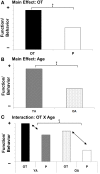Oxytocin and socioemotional aging: Current knowledge and future trends
- PMID: 24009568
- PMCID: PMC3755210
- DOI: 10.3389/fnhum.2013.00487
Oxytocin and socioemotional aging: Current knowledge and future trends
Abstract
The oxytocin (OT) system is involved in various aspects of social cognition and prosocial behavior. Specifically, OT has been examined in the context of social memory, emotion recognition, cooperation, trust, empathy, and bonding, and-though evidence is somewhat mixed-intranasal OT appears to benefit aspects of socioemotional functioning. However, most of the extant data on aging and OT is from animal research and human OT research has focused largely on young adults. As such, though we know that various socioemotional capacities change with age, we know little about whether age-related changes in the OT system may underlie age-related differences in socioemotional functioning. In this review, we take a genetic-neuro-behavioral approach and evaluate current evidence on age-related changes in the OT system as well as the putative effects of these alterations on age-related socioemotional functioning. Looking forward, we identify informational gaps and propose an Age-Related Genetic, Neurobiological, Sociobehavioral Model of Oxytocin (AGeNeS-OT model) which may structure and inform investigations into aging-related genetic, neural, and sociocognitive processes related to OT. As an exemplar of the use of the model, we report exploratory data suggesting differences in socioemotional processing associated with genetic variation in the oxytocin receptor gene (OXTR) in samples of young and older adults. Information gained from this arena has translational potential in depression, social stress, and anxiety-all of which have high relevance in aging-and may contribute to reducing social isolation and improving well-being of individuals across the lifespan.
Keywords: aging; amygdala; anterior cingulate; oxytocin; socioemotional functioning.
Figures




Similar articles
-
Associations between oxytocin receptor gene (OXTR) methylation, plasma oxytocin, and attachment across adulthood.Int J Psychophysiol. 2019 Feb;136:22-32. doi: 10.1016/j.ijpsycho.2018.01.008. Epub 2018 Feb 2. Int J Psychophysiol. 2019. PMID: 29410310 Free PMC article.
-
OXTR methylation modulates exogenous oxytocin effects on human brain activity during social interaction.Genes Brain Behav. 2020 Jan;19(1):e12555. doi: 10.1111/gbb.12555. Epub 2019 Feb 10. Genes Brain Behav. 2020. PMID: 30624029
-
A common oxytocin receptor gene (OXTR) polymorphism modulates intranasal oxytocin effects on the neural response to social cooperation in humans.Genes Brain Behav. 2015 Sep;14(7):516-25. doi: 10.1111/gbb.12234. Epub 2015 Aug 13. Genes Brain Behav. 2015. PMID: 26178189 Free PMC article.
-
Ageing and oxytocin: a call for extending human oxytocin research to ageing populations--a mini-review.Gerontology. 2013;59(1):32-9. doi: 10.1159/000341333. Epub 2012 Aug 24. Gerontology. 2013. PMID: 22922544 Review.
-
Hormones as "difference makers" in cognitive and socioemotional aging processes.Front Psychol. 2015 Jan 22;5:1595. doi: 10.3389/fpsyg.2014.01595. eCollection 2014. Front Psychol. 2015. PMID: 25657633 Free PMC article. Review.
Cited by
-
The Role of Intranasal Oxytocin on Social Cognition: An Integrative Human Lifespan Approach.Curr Behav Neurosci Rep. 2020 Dec;7(4):175-192. doi: 10.1007/s40473-020-00214-5. Epub 2020 Sep 12. Curr Behav Neurosci Rep. 2020. PMID: 33717829 Free PMC article.
-
Early life stress modulates amygdala-prefrontal functional connectivity: implications for oxytocin effects.Hum Brain Mapp. 2014 Oct;35(10):5328-39. doi: 10.1002/hbm.22553. Epub 2014 May 26. Hum Brain Mapp. 2014. PMID: 24862297 Free PMC article. Clinical Trial.
-
Genetics and functional imaging: effects of APOE, BDNF, COMT, and KIBRA in aging.Neuropsychol Rev. 2015 Mar;25(1):47-62. doi: 10.1007/s11065-015-9279-8. Epub 2015 Feb 10. Neuropsychol Rev. 2015. PMID: 25666727 Review.
-
Oxytocin Release Increases With Age and Is Associated With Life Satisfaction and Prosocial Behaviors.Front Behav Neurosci. 2022 Apr 21;16:846234. doi: 10.3389/fnbeh.2022.846234. eCollection 2022. Front Behav Neurosci. 2022. PMID: 35530727 Free PMC article.
-
Intranasal oxytocin modulates the salience network in aging.Neuroimage. 2022 Jun;253:119045. doi: 10.1016/j.neuroimage.2022.119045. Epub 2022 Mar 5. Neuroimage. 2022. PMID: 35259525 Free PMC article. Clinical Trial.
References
Grants and funding
LinkOut - more resources
Full Text Sources
Other Literature Sources
Research Materials

